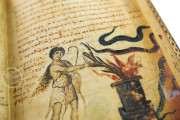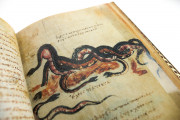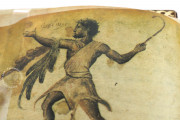The Paris Theriaca and Alexipharmaca by Nicander is the only surviving illustrated manuscript of the work of the ancient Greek poet. Although the stunning eleventh-century manuscript of the paired Greek texts is only a fragment comprising less than half of its original leaves, it features fifty-four colorful miniatures of human figures along with animals and plants.
Nicander of Colophon was a grammarian who lived in the second century BCE. A prolific writer, he worked at the court of Attalus III of Pergamon, and his works gained the praise of many classical authors for generations to come. Although the names of several of his lost works are known through citations by the likes of Ovid and Cicero, Theriaca and Alexipharmaca are the only two of his large-scale works that have survived for modern readers.
Greek Pharmacology
Commonly combined, the two pharmacological texts discuss a variety of poisons and their antidotes in hexameter verse, which help the reader remember the content. The Theriaca focuses on poisons from animal bites and stings, while the Alexipharmaca addresses poisons primarily of plant and mineral origin. In addition to describing the composition of the poisons and their symptoms, the texts also helpfully detail remedies for each. Since the writer was no physician, however, his descriptions sometimes reflect inherited superstitions.
Botanical and Zoological Miniatures
Lacking frames, the miniatures are found at the top, middle, or bottom of the pages and depict poisonous animals along with helpful and harmful plants. The human figures featured throughout are painted with great care and attention to detail.
It is unclear whether these images were faithfully copied from models handed down through the generations. There is, however, evidence that the images were important to the transmission of the texts at least as early as the third century CE when the scholar Tertullian wrote in his De scorpiace that Nicander both wrote and painted his texts.
Borrowed by Ermolao Barbaro
The manuscript's early movement is rather unclear. It seems to have been in Italy as early as the fifteenth century when the book appears on the loan register of the Vatican Library. It was borrowed by Ermolao Barbaro, a leading Renaissance authority on Greek and Latin works. According to a purchase note, the manuscript was acquired by the Abbey of Saint-Germain-des-Près in the eighteenth century. It was transferred to the Bibliothèque nationale (now the Bibliothèque nationale de France) during the French Revolution.
We have 1 facsimile edition of the manuscript "Theriaca and Alexipharmaca by Nicander": Theriaka y Alexipharmaka de Nicandro facsimile edition, published by M. Moleiro Editor, 1997
Request Info / Price



















